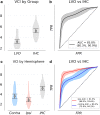Velocity Curvature Index: a Novel Diagnostic Biomarker for Large Vessel Occlusion
- PMID: 30293170
- PMCID: PMC6733810
- DOI: 10.1007/s12975-018-0667-2
Velocity Curvature Index: a Novel Diagnostic Biomarker for Large Vessel Occlusion
Abstract
Despite being a conveniently portable technology for stroke assessment, Transcranial Doppler ultrasound (TCD) remains widely underutilized due to complex training requirements necessary to reliably obtain and interpret cerebral blood flow velocity (CBFV) waveforms. The validation of objective TCD metrics for large vessel occlusion (LVO) represents a first critical step toward enabling use by less formally trained personnel. In this work, we assess the diagnostic utility, relative to current standard CT angiography (CTA), of a novel TCD-derived biomarker for detecting LVO. Patients admitted to the hospital with stroke symptoms underwent TCD screening and were grouped into LVO and control groups based on the presence of CTA confirmed occlusion. Velocity curvature index (VCI) was computed from CBFV waveforms recorded at multiple depths from the middle cerebral arteries (MCA) of both cerebral hemispheres. VCI was assessed for 66 patients, 33 of which had occlusions of the MCA or internal carotid artery. Our results show that VCI was more informative when measured from the cerebral hemisphere ipsilateral to the site of occlusion relative to contralateral. Moreover, given any pair of bilateral recordings, VCI separated LVO patients from controls with average area under receiver operating characteristic curve of 92%, which improved to greater than 94% when pairs were selected by maximal velocity. We conclude that VCI is an analytically valid candidate biomarker for LVO diagnosis, possessing comparable accuracy, and several important advantages, relative to current TCD diagnostic methodologies.
Keywords: Diagnostic imaging; Ischemic stroke; Large vessel occlusion; Transcranial Doppler; Ultrasound.
Conflict of interest statement
Samuel G. Thorpe, Corey M. Thibeault, Seth J. Wilk, Michael O’Brien, Nicolas Canac, Mina Ranjbaran, and Robert B. Hamilton are employed by and hold stock options in Neural Analytics, Inc. Thomas Devlin is a paid consultant and stockholder of Neural Analytics, Inc. Christian Devlin declares that he has no conflicts to disclose.
Figures





Similar articles
-
Decision Criteria for Large Vessel Occlusion Using Transcranial Doppler Waveform Morphology.Front Neurol. 2018 Oct 17;9:847. doi: 10.3389/fneur.2018.00847. eCollection 2018. Front Neurol. 2018. PMID: 30386287 Free PMC article.
-
Automated Detection of Intracranial Large Vessel Occlusions on Computed Tomography Angiography: A Single Center Experience.Stroke. 2019 Oct;50(10):2790-2798. doi: 10.1161/STROKEAHA.119.026259. Epub 2019 Sep 9. Stroke. 2019. PMID: 31495328
-
Large Vessel Occlusion in Acute Ischemic Stroke Patients: A Dual-Center Estimate Based on a Broad Definition of Occlusion Site.J Stroke Cerebrovasc Dis. 2020 Feb;29(2):104504. doi: 10.1016/j.jstrokecerebrovasdis.2019.104504. Epub 2019 Nov 21. J Stroke Cerebrovasc Dis. 2020. PMID: 31761735
-
A Review of the use of Transcranial Doppler Waveform Morphology for Acute Stroke Assessment.J Clin Neurosci. 2020 Nov;81:346-352. doi: 10.1016/j.jocn.2020.09.062. Epub 2020 Oct 23. J Clin Neurosci. 2020. PMID: 33222943 Review.
-
Diagnostic performance of single-phase CT angiography in detecting large vessel occlusion in ischemic stroke: A systematic review.Eur J Radiol. 2021 Jan;134:109458. doi: 10.1016/j.ejrad.2020.109458. Epub 2020 Dec 1. Eur J Radiol. 2021. PMID: 33302028
Cited by
-
Perioperative stroke: A perspective on challenges and opportunities for experimental treatment and diagnostic strategies.CNS Neurosci Ther. 2022 Apr;28(4):497-509. doi: 10.1111/cns.13816. Epub 2022 Feb 27. CNS Neurosci Ther. 2022. PMID: 35224865 Free PMC article. Review.
-
Emerging Detection Techniques for Large Vessel Occlusion Stroke: A Scoping Review.Front Neurol. 2022 Jan 6;12:780324. doi: 10.3389/fneur.2021.780324. eCollection 2021. Front Neurol. 2022. PMID: 35095726 Free PMC article.
-
Systematic review and meta-analysis of transcranial doppler biomarkers for the prediction of delayed cerebral ischemia following subarachnoid hemorrhage.J Cereb Blood Flow Metab. 2025 Jun;45(6):1031-1047. doi: 10.1177/0271678X251313746. Epub 2025 Mar 20. J Cereb Blood Flow Metab. 2025. PMID: 40110695 Free PMC article.
-
Large Vessel Occlusion Stroke Detection in the Prehospital Environment.Curr Emerg Hosp Med Rep. 2021 Sep;9(3):64-72. doi: 10.1007/s40138-021-00234-9. Epub 2021 Jun 28. Curr Emerg Hosp Med Rep. 2021. PMID: 36204242 Free PMC article.
-
Toward automated classification of pathological transcranial Doppler waveform morphology via spectral clustering.PLoS One. 2020 Feb 6;15(2):e0228642. doi: 10.1371/journal.pone.0228642. eCollection 2020. PLoS One. 2020. PMID: 32027714 Free PMC article.
References
-
- Saqqur M, Uchino K, Demchuk AM, Molina CA, Garami Z, Calleja S, Akhtar N, Orouk FO, Salam A, Shuaib A, Alexandrov AV, for CLOTBUST Investigators Site of arterial occlusion identified by transcranial Doppler predicts the response to intravenous thrombolysis for stroke. Stroke. 2007;38(3):948–954. doi: 10.1161/01.STR.0000257304.21967.ba. - DOI - PubMed
-
- Saver JL, Goyal M, van der Lugt A, Menon BK, Majoie CBLM, Dippel DW, Campbell BC, Nogueira RG, Demchuk AM, Tomasello A, Cardona P, Devlin TG, Frei DF, du Mesnil de Rochemont R, Berkhemer OA, Jovin TG, Siddiqui AH, van Zwam WH, Davis SM, Castaño C, Sapkota BL, Fransen PS, Molina C, van Oostenbrugge RJ, Chamorro Á, Lingsma H, Silver FL, Donnan GA, Shuaib A, Brown S, Stouch B, Mitchell PJ, Davalos A, Roos YBWEM, Hill MD, for the HERMES Collaborators Time to treatment with endovascular thrombectomy and outcomes from ischemic stroke: a meta-analysis. JAMA. 2016;316(12):1279–1288. doi: 10.1001/jama.2016.13647. - DOI - PubMed
Publication types
MeSH terms
Substances
LinkOut - more resources
Full Text Sources
Medical

